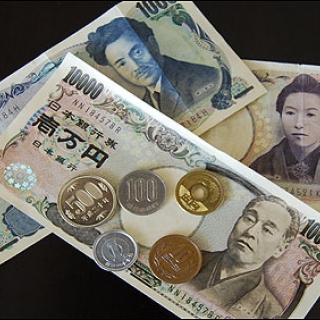


The Japanese Yen (JPY) attracted fresh buyers at the start of a new week and remained within striking distance of its highest level since late September 2024 hit against the broadly weakening US Dollar (USD) last Friday. Concerns about the rapidly escalating US-China trade war and its impact on the global economy continued to support traditional safe-haven assets, including the JPY. Further, hopes that Japan might reach a trade deal with the US turned out to be another factor offering support to the JPY.
Meanwhile, signs of broadening inflation in Japan keep the case for further interest rate hikes by the Bank of Japan (BOJ) open. In contrast, investors have been pricing in the possibility of aggressive policy easing by the Federal Reserve (Fed) amid concerns that the escalating US-China trade war will hamper US economic growth. This would result in a further narrowing of the interest rate differential between Japan and the US, suggesting that the path of least resistance for the low-yielding JPY is to the upside.
Japanese Yen supported by global flight to safety, BoJ rate hike bets
China's 84% tariffs on US goods came into effect on Thursday, while US President Donald Trump raised duties on Chinese imports to an unprecedented 145%. The developments fueled concerns about the potential economic impact of an escalating trade war between the world's two largest economies and drove some safe-haven flows into the Japanese Yen.
Investors remain optimistic about a positive outcome from US-Japan trade talks. In fact, Trump said last week that tough but fair parameters are being set for negotiations. Additionally, US Treasury Secretary Scott Bessent said that Japan may be a priority in tariff negotiations, fueling hopes for a possible US-Japan trade deal and further supporting the JPY. Japanese Prime Minister Shigeru Ishiba warned on Monday that "US tariffs have the potential to disrupt the world economic order.
" Separately, Japanese Finance Minister Shunichi Kato said that "the US and Japan share the view that excessive foreign exchange volatility is undesirable." In addition, Japanese Economy Minister Ryosei Akazawa stated that "foreign exchange issues will be handled by Finance Minister Kato and US Treasury Secretary Scott Bessent." Meanwhile, the Bank of Japan's preliminary report released last Thursday showed that annual wholesale inflation accelerated to 4.2% in March. This is a sign of persistent cost pressures, which, together with strong wage growth, should contribute to rising domestic inflationary pressures and allow the BoJ to continue raising interest rates this year.
In contrast, the latest reading of the US Consumer Price Index showed that inflation slowed sharply in March. This comes on top of weakening confidence in the US economy and should allow the Federal Reserve to resume its rate-cutting cycle. Moreover, market participants are now pricing in a possible 90 basis point rate cut by the end of this year. The divergent BoJ-Fed policy expectations turned out to be another factor that benefited the lower-yielding JPY. On the other hand, the US dollar languished near its lowest level since April 2022, hit on Friday. This, in turn, dragged the USD/JPY pair back closer to multi-month lows during the Asian session on Monday and supports prospects for a further decline.(Newsmaker23)
Source: FXstreet
USD/JPY pair edges higher to near 150.35, the highest since August 1, during the early Asian session on Tuesday. The Japanese Yen (JPY) weakens against the US Dollar (USD) on political stability conce...
Politics dominated currency markets on Monday as the Japanese yen weakened by the most against the dollar in five months as Sanae Takaichi looked set to become Japan's next prime minister, while the e...
The USD/JPY pair climbs to near 149.65 during the early Asian session on Monday. The Japanese Yen (JPY) faces some selling pressure against the Greenback after a ruling-party vote for Sanae Takaichi t...
The Japanese yen strengthened for the fifth straight day on Thursday, remaining near the two-week high reached the previous day as the US dollar weakened. Markets are increasingly accepting that the B...
The Japanese Yen (JPY) gains traction against the US Dollar (USD) on Tuesday, with USD/JPY extending losses for a third straight day as the looming United States (US) government shutdown weighs on the...
US stocks rose on Friday (October 17th) as investors reacted positively to President Trump's remarks alleviating concerns about further trade escalation with China, while regional bank stocks rebounded after Thursday's sharp declines. The S&P...
Oil prices posted a slight increase on Friday (October 17th), but were close to a weekly loss of nearly 3% after the International Energy Agency (IEA) forecast a widening oversupply, and U.S. President Donald Trump and Russian President Vladimir...
Gold prices (XAU/USD) fell 2% after hitting a record high of $4,379 on Friday (October 17th), falling below $4,250, triggered by comments by US President Donald Trump that triple-digit tariffs against China were unsustainable. At the time of...
 Federal Reserve Governor Christopher Waller said on Thursday he's on board with another interest rate cut at the U.S. central bank's policy meeting...
Federal Reserve Governor Christopher Waller said on Thursday he's on board with another interest rate cut at the U.S. central bank's policy meeting...

 Australia's unemployment rate jumped to 4.5% in September, its highest level since 2021. This figure was worse than expected and indicates that the...
Australia's unemployment rate jumped to 4.5% in September, its highest level since 2021. This figure was worse than expected and indicates that the...
 US President Donald Trump said he spoke with Russian President Vladimir Putin, a day before meeting with Ukrainian leader Volodymyr Zelenskiy. "This...
US President Donald Trump said he spoke with Russian President Vladimir Putin, a day before meeting with Ukrainian leader Volodymyr Zelenskiy. "This...